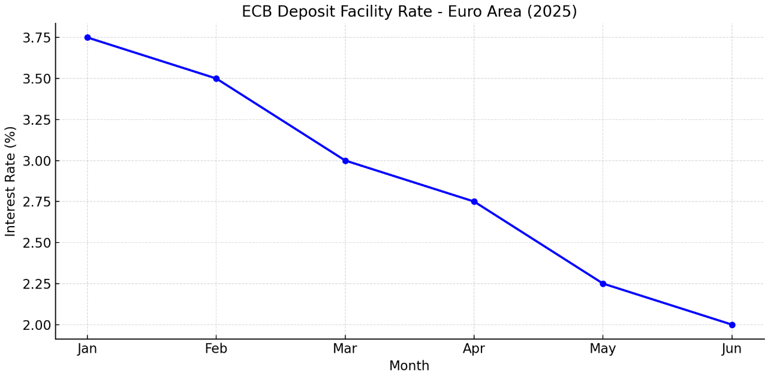European interest rates in 2025
FINANCE
Jakub De Vries
6/6/20252 min read


Introduction
Interest rates represent the cost of borrowing money and play a crucial role in determining the overall cost of debt. When rates are low, companies may be more inclined to issue equity to meet their financing needs. This article explores Europe's current interest rate environment in 2025 and examines its potential impact on corporate and household financing decisions.
Reasoning behind lowering interest rates
The European Central Bank is aware that operating costs for firms have significantly increased due to the high inflation rates that followed the COVID-19 pandemic. Although the full impact of these inflationary pressures is difficult to measure, partly because of the lag in policy transmission, the ECB has recognized the need for action. To support economic recovery, the European Union has opted to reduce the cost of borrowing for both firms and households. By lowering interest rates, the ECB aims to stimulate investment and consumption, enabling companies to expand their operations and sustain their presence in competitive markets.


European Central Bank. Official Interest Rates. ECB, 5 June 2025, https://www.ecb.europa.eu/stats/policy_and_exchange_rates/key_ecb_interest_rates/html/index.en.html
Firms:
With the availability of cheaper debt financing, firms may reduce their reliance on equity issuance to meet capital needs. Lower interest rates make borrowing more attractive, allowing companies to finance expansion or operations at a lower cost, thus preserving ownership and avoiding equity dilution.
Households:
Lower interest rates, particularly on mortgages, reduce household repayment burdens. This increases disposable income, enabling greater spending or saving. As a result, consumer demand may rise, further supporting economic growth.
All else being equal, under the rationality assumption
Effects of lower interest rates
Conclusion
Interest rates are a key monetary policy instrument, shaping borrowing and spending decisions across the economy. This article examined the effects of declining interest rates within the European Union. As rates have decreased, borrowing has become more accessible, encouraging corporate investment and household spending. At the same time, the lower yield environment has led to increased demand for fixed-income instruments, as investors seek stable returns in a low-rate setting.
